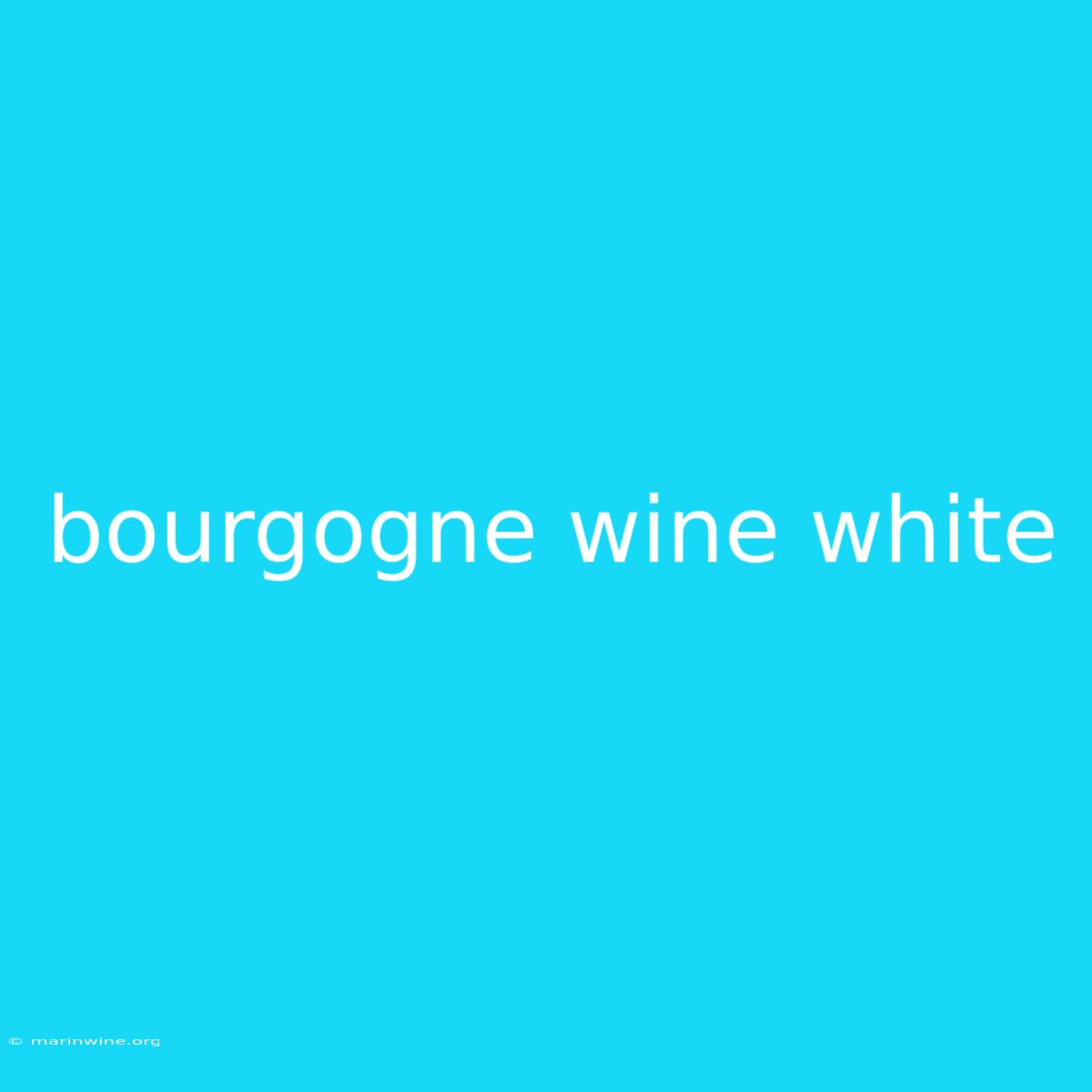Uncorking the Secrets of Bourgogne White Wine: A Journey of Elegance and Complexity
Have you ever wondered what makes Bourgogne white wine so exceptional? It's not just a name; it's a testament to a unique terroir, centuries-old tradition, and a commitment to producing some of the world's finest wines.
Why It Matters: Bourgogne white wine is a world-renowned treasure, offering a diverse spectrum of styles and aromas, from the crisp acidity of Chablis to the opulent richness of Meursault. This article will delve into the fascinating world of Bourgogne white, exploring its key characteristics, regional variations, and what makes it a coveted choice for wine lovers.
Key Takeaways of Bourgogne White Wine:
| Aspect | Description |
|---|---|
| Grape Varieties | Primarily Chardonnay, with small amounts of Aligoté |
| Regions | Chablis, Côte de Beaune, Côte Chalonnaise, Mâconnais, and others |
| Styles | Ranging from crisp and mineral-driven to rich and complex, depending on the region and producer |
| Flavors | Citrus, green apple, pear, hazelnut, brioche, and floral notes |
| Pairing | Seafood, chicken, pork, cheese, and rich dishes |
Bourgogne White Wine: A Symphony of Terroir and Tradition
The heart of Bourgogne white wine lies in its terroir: the unique combination of soil, climate, and human expertise that defines its character.
Key Aspects:
- Chardonnay: This dominant grape variety, known for its versatility, thrives in the unique terroir of Bourgogne.
- Climate: The region's continental climate, with warm summers and cold winters, contributes to the complexity and elegance of the wines.
- Soil: Varied soil types, from limestone and clay to marl and granite, play a crucial role in shaping the aromas and flavors of Bourgogne white.
- Winemaking Techniques: Traditional practices, including long fermentation and aging in oak barrels, contribute to the richness and longevity of the wines.
Exploring the Regional Differences
Chablis: Known for its crisp, mineral-driven style, Chablis wines are characterized by notes of flint, oyster shell, and citrus. The limestone-rich soil plays a key role in defining this unique style.
Côte de Beaune: This prestigious region boasts a range of white wines, from the elegant and complex Meursault to the vibrant and fruity Puligny-Montrachet. The terroir is diverse, with a mix of limestone, clay, and marl soils.
Côte Chalonnaise: Often overlooked, this region offers exceptional value for money, producing rich, fruity whites with hints of honey and spice. The soil consists mainly of limestone and marl.
Mâconnais: Situated further south, this region produces fruity and approachable white wines, often with a hint of sweetness. The soil is composed of clay, limestone, and sandstone.
Connecting the Dots: Bourgogne White Wine and Food Pairing
The versatility of Bourgogne white wine makes it a perfect companion for a wide range of dishes.
Seafood: The crisp acidity of Chablis complements the delicate flavors of oysters, shellfish, and grilled fish.
Chicken and Pork: The richness and complexity of Meursault pair beautifully with roasted chicken and pork dishes.
Cheese: The buttery notes of Bourgogne white wine complement the richness of cheese, from mild goat cheeses to aged cheddar.
Rich Dishes: The complexity of the wines can stand up to rich dishes like mushroom risotto, creamy pasta sauces, and even spicy curries.
FAQ for Bourgogne White Wine:
Q: How long can Bourgogne white wine be aged? A: High-quality Bourgogne white wines, especially from prestigious producers and regions, can age for decades, developing complex aromas of honey, toast, and nuts.
Q: What are the different levels of classification in Bourgogne white wine? A: Bourgogne white wine is classified according to the vineyard site and the quality of the grapes, ranging from simple Bourgogne Blanc to Grand Cru wines like Montrachet and Corton-Charlemagne.
Q: How can I tell if a Bourgogne white wine is good quality? A: Look for wines from reputable producers, with a clear indication of the vineyard site and vintage. Look for wines that are bottled in the region and sealed with a "Bourgogne" label.
Tips for Enjoying Bourgogne White Wine:
- Serve chilled: The ideal serving temperature for Bourgogne white wine is around 45-50°F (7-10°C).
- Use the right glass: Choose a Burgundy glass, which has a larger bowl to allow the wine to breathe and release its aromas.
- Decant older wines: Decanting can help to aerate older wines and bring out their complexity.
Summary of Bourgogne White Wine:
This exploration of Bourgogne white wine has revealed a world of exceptional quality, diversity, and complexity. From the crisp minerality of Chablis to the opulent richness of Meursault, these wines offer a unique experience for any wine lover. Understanding the key aspects of terroir, regional differences, and food pairing will enhance your appreciation for this exquisite wine region.
Closing Message: Uncorking a bottle of Bourgogne white wine is an invitation to a sensory journey. Embrace the elegance, the complexity, and the history that each sip offers, and discover why this region continues to captivate wine enthusiasts worldwide.

